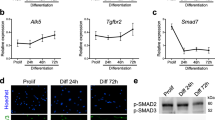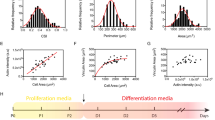Summary
Our previous studies have demonstrated that expression of growth-associated genes is regulated by the adhesive state of the cell. To understand the role of cell adhesion in regulating the switch from growth to differentiation, we are studying the differentiation of mouse myoblasts into multinucleated contractile myotubes. In this report, we describe a novel means of culturing C2C12 myoblasts that permits an analysis of the role of cell adhesion in regulating the sequential induction of muscle-specific genes that control myogenesis. Suspension of an asynchronous, proliferating population of myoblasts in a viscous gel of methylcellulose dissolved in medium containing 20% serum induces growth arrest in G0 phase of the cell cycle without a concomitant induction of muscle-specific genes. Reattachment to a solid substratum in 20% serum, 0.5nM bFGF, or 10 nM IGF-1 rapidly activates entry of the quiescent cells into G1 followed by a synchronous progression of the cell population through into S phase. bFGF or IGF-1 added separately facilitate only one passage through the cell cycle, whereas 20% serum or the two growth factors added together support multiple cell divisions. Adhesion of suspended cells in DMEM alone or with 3 nM IGF-1 induces myogenesis as evidenced by the synthesis of myogenin and myosin heavy chain (MHC) proteins followed by fusion into myotubes. bFGF completely inhibits this differentiation process even in the presence of myogenic doses of IGF-1. Addition of 3 nM IGF-1 to quiescent myoblasts maintained in suspension culture in serum-free conditions does not induce myogenin or MHC expression. Thus, adhesion is a requirement for the induction of muscle gene expression in mouse myoblasts. The development of a muscle cell culture environment in which proliferating myoblasts can be growth arrested in G0 without activating muscle-specific gene expression provides a means of analyzing the synchronous activation of either the myogenic or growth programs and how adhesion affects each process, respectively.
Similar content being viewed by others
References
Abercrombie, M.; Heaysman, J. E. Observations of cells in tissue culture. Exp. Cell Res. 5:111–118 1953.
Adams, J. C.; Watt, F. M. Fibronectin inhibits the terminal differentiation of human keratinocytes. Nature (Lond.) 340:307–309; 1989.
Adams, J. C.; Watt, F. M. Regulation of development and differentiation by the extracellular matrix. Development (Camb.) 117:1183–1198; 1993.
Bader, D.; Masaki, T.; Fischman, D. A. Immunochemical analysis of myosin heavy chain during avian myogenesisin vivo andin vitro. J. Biochem. (Tokyo) 95:763–770; 1982.
Bauer, K. D.; Dethlefsen, L. A. Total cellular RNA content: correlation between flow cytometry and ultraviolet spectroscopy. J. Histochem. Cytochem. 28:493–499; 1980.
Benya, P. D.; Shaffer, J. D. Dedifferentiated chondrocytes reexpress the differentiated collagen phenotype when cultured in agarose gels. Cell 30;215–224; 1982.
Bissell, D. M.; Arenson, D. M. Maher, J. J., et al. Support of cultured hepatocytes by a laminin-rich gel. Evidence for a functionally significant subendothelial matrix in normal rat liver. J. Clin. Invest. 79:801–812; 1987.
Blau, H. M.; Pavlath, G. K.; Hardeman, E. C., et al. Plasticity of the differentiated state. Science (Wash. DC). 230:758–766; 1985.
Chomczynski, P.; Sacchi, N. Single-step method of RNA isolation by acid guanidinium thiocyanate-phenol-chloroform extraction. Anal. Biochem. 162:156–159; 1987.
Clegg, C. H.; Linkhart, T. A.; Olwin, B. B., et al. Growth factor control of skeletal muscle differentiation: commitment to terminal differentiation occurs in G1 phase and is repressed by fibroblast growth factor. J. Cell Biol. 105:949–956; 1987.
Coulson, P. B.; Bishop, A. O.; Lenarduzzi, R. Quantitation of cellular deoxyribonucleic acid by flow microfluorometry. J. Histochem. Cytochem. 25:1147–1153; 1977.
Darzynkiewicz, Z. Differential staining of DNA and RNA in intact and isolated cell nuclei with acridine organge. Methods Cell Biol. 33:285–298; 1990.
Dhawan, J.; Farmer, S. R. Regulation of alpha 1(I)-collagen gene expression in response to cell adhesion in Swiss 3T3 fibroblasts. J. Biol. Chem. 265;9015–9021; 1990.
Dhawan, J.; Lichtler, A. C.; Rowe, D. W., et al. Cell adhesion regulates pro-alpha 1(I) collagen mRNA stability and transcription in mouse fibroblasts. J. Biol. Chem. 266:8470–8475; 1991.
Dike, L. E.; Farmer, S. R. Cell adhesion induces, expression of growth-associated genes in suspension-arrested fibroblasts. Proc. Natl. Acad. Sci. USA 85:6792–6796; 1988.
Edmondson, D. G.; Cheng, T. C.; Cserjesi, P., et al. Analysis of the myogenin promoter reveals an indirect pathway for positive autoregulation mediated by the muscle-specific enhancer factor MEF-2. Mol. Cell. Biol. 12;3665–3677; 1992.
Farmer, S. R.; Dike, L. E. Cell shape and growth control: role of cytoskeleton-extracellular matrix interactions. In: Stein, W. D.; Bronner, F., eds. Cell shape: determinants, regulation, and regulatory role. San Diego, CA: Academic Press; 1989;173–202.
Florini, J. R.; Ewton, D. Z.; Magri, K. A. Hormones, growth factors, and myogenic differentiation. Annu. Rev. Physiol. 53:201–216; 1991.
Goodrich, D. W.; Wang, N. P.; Qian, Y. W., et al. The retinoblastoma gene product regulates progression through the G1 phase of the cell cycle. Cell 67:293–302; 1991.
Grounds, M. D. Towards understanding skeletal muscle regeneration. Pathol. Res. Pract. 187:1–22; 1991.
Grounds, M. D.; Garrett, K. L.; Lai, M. C., et al. Identification of skeletal muscle precursor cells in vivo by use of MyoD1 and myogenin probes. Cell Tissue Res. 267:99–104; 1992.
Gu, W.; Schneider, J. W.; Condorelli, G. et al. Interaction of myogenic factors and the retinoblastoma protein mediates muscle cell commitment and differentiation. Cell 72:309–324; 1993.
Guadagno, T. M.; Assoian, R. K. G1/S control of anchorage-independent growth in the fibroblast cell cycle. J. Cell Biol. 115;1419–1425; 1991.
Gulati, A. K. Basement membrane component changes in skeletal muscle transplants undergoing regeneration or rejection. J. Cell. Biochem. 27:337–346; 1985.
Hansen, L. K.; Mooney, D. J.; Vacanti, J. P., et al. Integrin binding and cell spreading on extracellular matrix act at different points in the cell cycle to promote hepatocyte growth. Mol. Biol. Cell. 5:967–975; 1994.
Kornberg, L. J.; Earp, H. S.; Turner, C. E., et al. Signal transduction by integrins: increased protein phosphorylation caused by clustering of beta 1 integrins. Proc. Natl. Acad. Sci. USA 88:8392–8396; 1991.
Li, M. L.; Aggeler, J.; Farson, D. A., et al. Influence of a reconstituted basement membrane and its components on casein gene expression and secretion in mouse mammary epithelial cells. Proc. Natl. Acad. Sci. USA 84:136–140; 1987.
Lin, C. Q.; Bissell, M. J. Multi-faceted regulation of cell differentiation by extracellular matrix. FASEB J. 7:737–743; 1993.
MacPherson, I.; Montagnier, L. Agar suspension culture for the selective assay of cells transformed by polyoma virus. Virology 23:291–294; 1964.
Menko, A. S.; Boettiger, D. Occupation of the extracellular matrix receptor, integrin, is a control point for myogenic differentiation. Cell 51:51–57; 1987.
Ontell, M. Neonatal muscle: an electron microscopic study. Anat. Rec. 189:669–690; 1977.
Pairault, J.; Green, H. A study of adipose conversion of suspended 3T3 cells by using glycerophosphate dehydrogenase as a differentiation marker. Proc. Natl. Acad. Sci. USA 76:5138–5142; 1979.
Rana, B.; Mischoulon, D.; Xie, Y., et al. Cell-extracellular matrix interactions can regulate the switch between growth and differentiation in rat hepatocytes: reciprocal expression of C/EBP alpha and immediate-early growth response transcription factors. Mol. Cell. Biol. 14:5858–5869; 1994.
Rosenthal, N. Muscle cell differentiation. Curr. Opin. Cell Biol. 1:1094–1101; 1989.
Rudnicki, M. A.; Schnegelsberg, P. N.; Stead, R. H., et al. MyoD or Myf-5 is required for the formation of skeletal muscle. Cell 75:1351–1359; 1993.
Sambrook, J.; Fritsch, E.F.; Maniatis, T. Molecular cloning: a laboratory manual. Cold Spring Harbor Laboratory Press; 1989; Cold Spring Harbor, NY.
Schumperli, D. Cell-cycle regulation of histone gene expression. Cell 45:471–472; 1986.
Schwartz, M. A.; Lechene, C.; Ingber, D. E. Insoluble fibronectin activates the Na/H antiporter by clustering and immobilizing integrin alpha 5 beta 1, independent of cell shape. Proc. Natl. Acad. Sci. USA 88:7849–7853; 1991.
Shin, S.; Freedman, V. H.; Risser, R., et al. Tumorigenicity of virus-transformed cells in nude mice is correlated specifically with anchorage independent growth in vitro. Proc. Natl. Acad. Sci. USA 72:4435–4439; 1975.
Stoker, M.; O'Neill, C.; Berryman, S., et al. Anchorage and growth regulation in normal and virus-transformed cells. Int. J. Cancer 3:683–693; 1968.
Tapscott, S. J.; Weintraub, H. MyoD and the regulation of myogenesis by helix-loop-helix proteins. J. Clin. Invest. 87:1133–1138; 1991.
Wittelsberger, S. C.; Kleene, K.; Penman, S. Progressive loss of shaperesponsive metabolic controls in cells with increasingly transformed phenotype. Cell 24:859–866; 1981.
Author information
Authors and Affiliations
Additional information
Supported by training grant T32-HL07035
Rights and permissions
About this article
Cite this article
Milasincic, D.J., Dhawan, J. & Farmer, S.R. Anchorage-dependent control of muscle-specific gene expression in C2C12 mouse myoblasts. In Vitro Cell.Dev.Biol.-Animal 32, 90–99 (1996). https://doi.org/10.1007/BF02723040
Received:
Accepted:
Issue Date:
DOI: https://doi.org/10.1007/BF02723040




